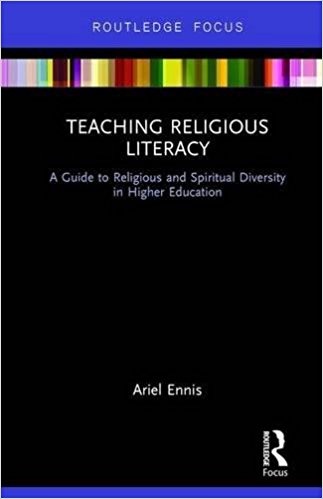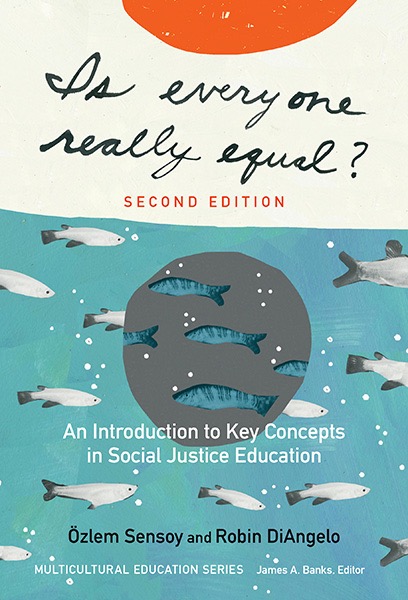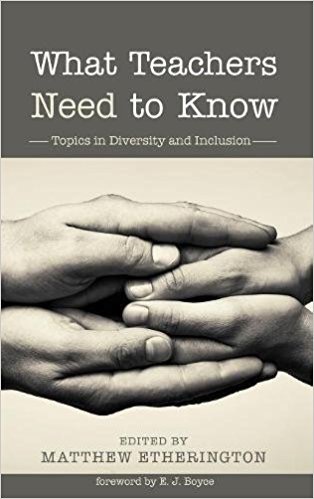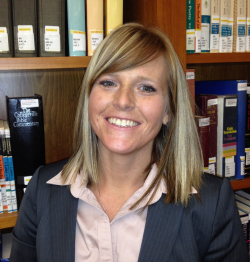diversity
Select an item by clicking its checkbox

Teaching Religious Literacy: A Guide to Religious and Spiritual Diversity in Higher Education
Date Reviewed: October 1, 2018
Ariel Ennis, Assistant Director and Senior Multifaith Educator at the Of Many Institute for Multifaith Leadership in the Office of Global Spiritual Life at New York University, has authored an important contribution to a burgeoning literature on campus-based interfaith and interreligious outreach. Noting that diversity and inclusion initiatives on American campuses frequently address race, sexuality, and gender while ignoring religious identity, Ennis reports on efforts at NYU to create a center to support spiritual life. Special attention is given to the development of a “Faith Zone” curriculum that trains leaders for enhanced multifaith encounters.
Ennis analyzes a variety of extant approaches to cross-cultural religious and spiritual experiences, looking at intended outcomes of different programs. Focusing on the concept of “religious literacy,” he describes a framework for the NYU workshops on spiritual diversity that supports religious literacy initiatives. Included in the book is the Faith Zone curriculum and rubrics drawn from the AACU (Association of American Colleges and Universities) VALUE rubrics that are used for post-workshop outcomes assessment. He shares data from these assessments in order to demonstrate the impact on campus of the religious literacy curriculum. The book closes with the author’s reflections on how Faith Zone workshops could be offered on different types of campuses (public/private, religious/secular) and with his recommendations for successfully meeting challenges emerging from the workshops.
Campus religious literacy initiatives that Ennis advocates embrace the question: Can we teach people to have more productive conversations about religion and spirituality in diverse settings? Using the definition of religious literacy developed by Dianne Moore of the Religious Literacy Project at Harvard Divinity School, Ennis answers this question affirmatively, setting four outcomes for the interfaith curriculum. Workshops will (1) enhance participants’ knowledge of historic and contemporary interconnections of religion with cultural, political, and social life; (2) embrace an ecumenical orientation that offers participants firsthand experience in exploring religio-cultural boundaries; (3) promote self-awareness about the intersections of participants\' religio-spiritual identities with larger social forces; and (4) encourage participants\' commitment to apply their new found religious literacy through practical projects that bridge intercultural divides.
In contrast to Eboo Patel’s portrait of a fraught relationship between interfaith outreach and religious studies programs (https://www.wabashcenter.wabash.edu/scholarship/interfaith-leadership-a-primer/), Ennis’ book points to positive implications for partnerships on campus between religious studies programs and interfaith outreach. Similarities between Faith Zone outcomes and learning outcomes/assessment of the religion major on many campuses suggest productive cross-fertilization. Students could sustain the long-term impact of the workshop outcomes, adding depth and breadth, through coursework in religious studies grounded in similar learning outcomes. In complementary fashion, religious studies majors could apply learning in the major outside the classroom, enhancing their resumes, through interfaith internships: as graduates of Faith Zone training, they could lead workshops on religious literacy and develop and lead associated campus programming.

Is Everyone Really Equal? An Introduction to Key Concepts in Social Justice Education
Date Reviewed: March 23, 2018
This book is one among fifty others within the Multicultural Education Series. According to the series editor James A. Banks, these books “[summarize and analyze] important research, theory, and practice related to the education of ethnic, racial, cultural, and linguistic groups in the United States and education of mainstream students about diversity” (xiii). Özelm Sensoy and Robin DiAngelo’s book focuses on social justice. For distinction from the commonplace notion of social justice, Sensoy and DiAngelo use the alternative term “critical social justice.” By critical social justice, they mean: (1) recognition of unequal social power relations at the individual and group levels in society; (2) understanding of one’s place within these relations of unequal power; (3) critical thinking on what knowledge is and how it is produced and acquired; and (4) action informed by the best understanding of what social justice is and sound methods for its realization in society (xxi). Sensoy and DiAngelo provide guidelines for teaching and learning social justice.
The book consists of twelve chapters. The chapters include: pictures; charts; figures; vocabulary lists; boxes for definitions of key terms and reminders of ideas and concepts if discussed in a previous chapter; questions for discussion; and instructions for learning activities. The authors intend for persons to read the chapters in their numerical order. The content of the book is cumulative, with each chapter building upon the one that precedes it.
There is an underlying logic in the linear progression of the chapters. Chapters 1 and 2 deal with instructional matters, providing students with guidelines for learning social justice course content (6-18), instructors with guidelines for grading student performance (19-21), and both with an overview of critical theory in social justice courses (25-27). Chapters 3 to 5 define the concepts and operations of culture, socialization, prejudice and discrimination, and oppression and domination (36-40, 51-57, 61-73). Chapters 6 to10 define ableism, sexism, racism, and classism and describe how they pervade social institutions (82-86, 104-115, 123-129, 142-144, 156-162, 177-182). Chapter 11 refutes 13 common statements that are used to discredit social justice education (186-197). Based on Sensoy and DiAngelo’s definition of critical social justice, Chapter 12 specifies four learning outcomes for social justice education and crafts possible scenarios for illustration of the kinds of actions for each outcome (200, 203-204, 207, 211).
Though written primarily for white readers, Sensoy and DiAngelo’s book merits consideration by all readers interested in social justice education in pluralistic society. The series editor notes that “most of the nation’s teachers are white, female, and monolingual” (xii). Using the terms “we” and “us” throughout the book, Sensoy and DiAngelo acknowledge their associations with this demographic group (120). Given the fact of intersectionality – that any one person has multiple associations – race or ethnicity cannot be a person’s only identification (138, 175). The complexity of human subjectivity warrants the concern of all persons with social justice in a world characterized by ever-increasing diversity.

What Teachers Need to Know: Topics in Diversity and Inclusion
Date Reviewed: January 22, 2018
What Teachers Need to Know (Etherington, 2017) is a substantial text defining the diverse and inclusive experiences of contemporary education systems. The book is a compilation with three major parts: “Ethics,” “Inclusion and Teacher Management,” and “Worldview and Story.” Each chapter provides reading questions for use in a classroom setting or for deeper reflection. This is well-suited for an audience in higher education, especially for readers who could share personal experiences with diversity and inclusion topics after a practicum or time teaching. I would recommend this book for a post-graduate education library.
The first part, “Ethics,” includes works by Sherick Hughes, Martyn Rouse, Jonathan Anuik, Chet Bowers, Eva Maria Waibel, the editor, Matthew Etherington, and James Dalziel. There is quite a range of topics in this section, but the Wabash Center reader might be particularly interested in Anuik\'s essay on faith-informed discourse. It is a study about the influence of missionary education on Indigenous beliefs, and how that reaches into Canadian public education today. It compels the reader to contemplate whether church and state can truly be separate in an educational context when there is such a significant inheritance of practice and values from a period dominated by religious influence.
Part Two, “Inclusion and Teacher Management,” includes works by Peter J. Froese, Ken Pudlas, Lucinda Spaulding, Karen Copeland, Bruce Shelvey, and Ken Bradley. Spaulding\'s essay reflects the current shift of attention to patterns of bullying and puts forward the mechanisms school communities can provide for the resiliency of the students. Other essays in this section discuss topics such as mental health, special needs, and even bring in the parents\' view on these issues as they exist in the educational system. This is an exceptional collection of essays on inclusivity.
The third and final part, “Worldview and Story,” includes works by the editor, Matthew Etherington, Edward R. Howe, Adam Forsyth, Leo Van Arragon, Christina Belcher, and Cynthia à Beckett. This section has the most obvious correlation to religious studies within educational contexts. Topics include: tolerance, science and religion, and epistemology. This section could serve as an excellent initial reading for students in a practical theology or other contemporized religious studies capstone course.
This book might not be a comfortable read in a public classroom, but maybe that is exactly why it should be read. Etherington\'s compilation offers academic theological reflection for secularized educational contexts. This book could be useful in a range of contexts. It may be particularly helpful to new teachers, parent associations, pastors of students, and community leaders.

Teaching Interreligious Encounters
Date Reviewed: January 22, 2018
As many of the contributors to Teaching Interreligious Encounters point out, interactions with people of diverse religious commitments are becoming more frequent in the workplace, in civic affairs, and in many neighborhoods. Consequently, there is a need to help individuals develop the attitudes and aptitudes that will enable them to conduct those encounters in an informed, respectful, and personally satisfying fashion. This volume argues that education, particularly in the undergraduate classroom, can make a substantial contribution to preparing individuals to understand and participate effectively in a religiously diverse society. To that end, the contributors offer an array of resources, comments on course and assignment design, and concrete strategies to show students how to conduct themselves in and learn from “interreligious encounters.”
Precisely what is entailed in such encounters and how they are to be enacted and understood receive a variety of answers throughout the book. At times, whatever lines might separate interfaith engagement from interreligious encounters, and either from comparative theology, and all of them from comparative religion do not appear in sharp focus. Some authors appear to use at least several of those terms as rough equivalents, while others strive to define their terms very clearly. For example, Eboo Patel and Cassie Meyer propose that “interfaith or interreligious studies is concerned primarily with the interactions between lived religious and nonreligious actors and communities” (300). Thus, they differentiate it from “comparative religions, comparative theology, and world religions” which they see as being less concerned with actual relationships and interactions. But several contributors cite with approval Francis Clooney’s statement that comparative theology “entails the interpretation of the meaning and truth of one’s own faith by means of a critical investigation of other faiths” (see 45), which would bring it closer to Patel and Meyer’s understanding of interfaith and interreligious studies.
How to construct courses, course modules, and individual assignments to promote what Patel and Meyer call “interfaith literacy” receives a lot of attention. Joshua Brown, for example, describes and analyzes a course on political theology that uses examples from Christianity and Chinese religions. Jonathan Edelman provides a detailed consideration of the Bhagavad Gita as a theological text. Other authors focus more on pedagogical strategies. In one of the more interesting contributions, Devorah Schoenfeld and Jeanine Diller describe how they use the Jewish process of hevruta to encourage students to disagree with each other in their interpretations of texts while still remaining in conversation, recognize disagreements within and among religions, and value interreligious disagreement. Emily Sigalow and Wendy Cadge make a clear and strong case for the value of using case studies in teaching about interreligious encounters, something that several other contributors also mention.
Most of the contributions emphasize that students can learn something personally valuable and meaningful from studying and especially participating in interactions with people who have religious commitments different than their own. This volume offers a rich set of suggestions about how to design and structure such learning opportunities.
It has now been over a full year since the 2016 presidential election. Yet, I still remember vividly the dark and raw thoughts I had the morning of November 9, 2016. When I woke up and learned of the election results, I was horrified that so many people had made a conscious decision ...
